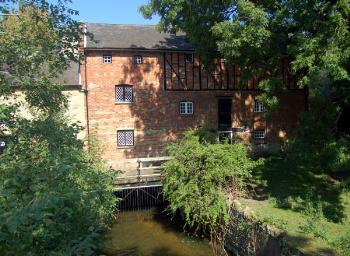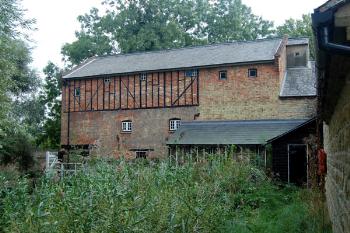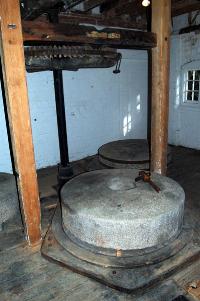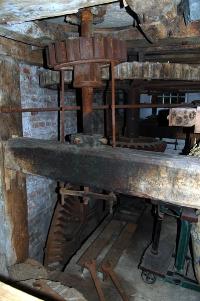
Bromham Mill in August 2007
The Domesday Book of 1086 recorded two mills in Bromham, one part of the land holding of Hugh de Beauchamp, the other owned by Countess Judith; it is possible that one of these lay on or near the site of the current building. Perhaps the first reference to the mill after Domesday occurs in a case at law in 1202 noted in Bedfordshire Historical Records Society publications volume I which refers to a "raised pond" in Bromham, which may well be a reference to the mill dam. Other early references include the drowning of a woman "by the mill wheel" in 1247 [BHRS volume XXI], the fact that Ralph Passelewe held two mills in 1279 [BHRS Vol.69] and mention of two mills in a Recovery Roll of 1602 [WW296]. By this date two mills probably means two pairs of mill stones under one roof.

Bromham Mill August 2007
By 1604 a mill, owned by Sir John Dyve as part of Bromham Manor, stood here, or near here, as he was indicted in the Court of Wards and Liveries for penning up the water at the mill so that it overflowed the fields, damaging the land of a royal ward - a member of the Boteler family of Biddenham with whom the Dyves were conducting a virtual war [TW1028-1029]. Bedfordshire and Luton Archives and Records Service has no title deeds to the mill but it remained part of the Manor of Bromham into the 20th century. A conveyance of 1652 [WW15] lists the mill as: "three corn mills [meaning three pairs of grinding stones] under one roof…in occupation of George Casse". Casse had been miller for some time as the Bromham Parish registers note the baptism of Elizabeth, his daughter, in 1622 when he is referred to as "milner".

Bromham Mill from the rear - September 2007
In 1670 the river at the mill was being used to wash sheep because a case was brought before the Assizes in that year concerning sheep stealing whilst they were being washed [HSA1670W110]. It may be that the present structure dates from around this time since The Victoria County History of 1912 noted that the mill had a date of 1695 inscribed on one of its door jambs with a stone outside dated 1722
![The Miller's House about 1880 [Z50/21/6]](/CommunityHistories/Bromham/Bromhamimages/Z50-21-6 Bromham Mill House about 1880_350x235.jpg)
The Miller's House about 1880 [Z50/21/6]
From at least 1707 to his death in 1732 Thomas Brown rented the mill; in a renewal of his lease in 1719 the property was described as: "all those watermills comonly [sic] called Bromham Mills with a messuage, cottage or tenement lying near the same comonly called the Miller's House and certain lands". The mill tools were specified as: nine mill bills; one sledge hammer; two bars of iron; three pairs of pulleys and ropes; four toll hutches; one brass toll dish.

The MIller's House September 2007
From at least 1796 the tenants of the mill were the Biggs family - William dying in 1799 and leaving the tenancy to his son John Barret Biggs. In the same year the son was indicted at the Quarter Sessions for: "a certain edificie [sic] and building comonly called a watermill with bricks, timber and other materials wrongfully, unlawfully and injuriously did erect, build and set up near to the King's common highway…and the said John Biggs caused the said watermill to be set ongoing by means whereof and of the appearance, motion and noise of the said watermill and of the wheels belonging to the same" This meant that: "the liege subjects of our said Lord the King could not, nor yet can, through and along the said King's common highway with their Horses, Coaches, Carts and Carriage go, return, ride, pass and labor [sic] as they were used and accustomed and ought to do without great danger to their lives". Biggs was found guilty and fines a shilling, it is not stated whether he had to pull the buildings down or simply deaden the noise so that the horsed transport was not adversely affected by it. The last mention of the Biggs family at Bromham Mill is in Kelly's Directory of 1885. In the directories of 1894 and 1898 Thomas Harrison is listed as miller and in that for 1903 Thomas Chibnell Harrison. By 1910 R. Quenby & Sons are listed as millers.

The mill wheel
A date stone of 1858 is set high into the west gable extension of the mill. It is likely that this refers to a rebuilding. In 1927 the mill was valued under the Rating Valuation Act 1925, in his notebook [DV1/C/3 pp.1-4] the value noted that it was owned by Harry Quenby, who had purchased it in 1924 (the 1922 Law of Property Act had abolished copyhold tenure and in the years following the land was steadily enfranchised to its supposed tenants); the occupiers were, unsurprisingly, R. Quenby & Sons on a 21 year lease from 1905 "H. Quenby did pay to Wingfield Estate. Now daughter pays same to him". The mill itself was described as containing a ground floor office and stores whilst on the first floor and parts of two other floors were: five pairs of stones ("usually use 3 pairs"); a mill for beans and maize; an oat roller; a grist mill; a chaff cutter and a cleaning machine. The valuer noted "water not always sufficient" and "No power besides River when river gets low use one pair only". Attached to the mill were a stable for four horses, a barn, five pig sties, a loose box, shed and eight hovels. "Miller could not give sack capacity. Say 4 because it varies so much…" The mill included 10.867 acres, being two field, numbered 55 and 57 on the Ordnance Survey map. The valuer noting: "Good grass meadows should say both flood but [field number] 57 most. By Bromham Mill".
![Mary Quenby at Bromham Mill in 1917 [Z50/141/517]](/CommunityHistories/Bromham/Bromhamimages/Z50-141-517 Mary Quenby at Bromham Mill 1917_218x300.jpg)
Mary Quenby at Bromham Mill in 1917 [Z50/141/517]
The Mill House was also owned by Quenby but was occupied by G.A.R.Church. It was built of brick, stone and thatch, being described as stone faced and "very nice". It contained a dining room, drawing room, kitchen and pantry downstairs with three bedrooms, a bathroom and wc upstairs; outside were a shed, an incubator house (presumably for eggs) and a small garage. The valuer noted: "Pump water from well to tank. Electric light". The house overlooked the mill, standing near the road; the valuer was clearly taken with it as he additionally noted: "Nice little place". The Victoria County History notes that the miller's house "was pulled down some years ago and a modern one built in its stead".

A peak stone and mill bill 2007
Bedfordshire County Council Historic Environment Record has an inventory of the mill in 1942 which includes elevators, deck hoists, worm conveyors, Geyser mixers, roller mill, grinding mills, shafts, belts, Avery weighing machines, sack trucks, hoppers, Avery counter scales, office furniture, Petter oil engine, cooling tanks, oil tanks, Porteous cereal cutter and grinders, dust collectors, Brook electric motor, Howes wheat scourer, rotary separator, Turner Warehouse separator and cylinders, Grain Cleaners Limited dry seed dresser, Crompton Parkinson electric motor, Bentall oil cake mill, screw cutting lathe, portable air compressor, oil cabinet and pump, workshop equipment and furniture, ladders, Morris 6 cylinder 25 horsepower engine, tools, Laurence Scott electric motor, acid carboys, Avery 6 ton weighbridge, petrol pumps and 500 gallon and 300 gallon underground petrol tanks, hay trussing machine and sacks.

Inside the mill 2007
In 1971 Quenby Price Limited leased the mill buildings, mill house and 6½ of land to Bedfordshire County Council as a picnic site, selling them to the council two years later [CCE2839]. After Quenby Price moved out in February 1971, the Mill was taken over by artisans making pottery and leather goods until a fire broke out on 20 February 1974 at 10.15pm in an upper floor storeroom. The roof was destroyed along with the upper floor at the east end. The Fire Service concluded that the fire had been caused by an electrical fault.

Mill gears at Bromham Mill 2007
Bedfordshire County Council began restoration of the mill in 1977 and in 1980 the gear was restored to working order by P. H. Gormley of Hatton [Derbyshire]. The mill remaied in County Council ownership until the council was abolished in April 2009 at which point ownership was taken over by Bedford Borough Council. The building is available for hire for functions and is open to the public at various times. The mill continues to grind corn.
![Bromham Mill in 1962 [Z53/21/19]](/CommunityHistories/Bromham/Bromhamimages/Z53-21-19 Bromham Mill in 1962_208x300.jpg)
Bromham Mill in 1962 [Z53/21/19]
A few stray references to millers other than those mentioned above are held by Bedfordshire & Luton Archives & Records Service as follows:
- Thomas Gurney: 1688 an administration of his effects on his death;
- Robert Wilsher: his burial in 1789 being recorded in the parish register.